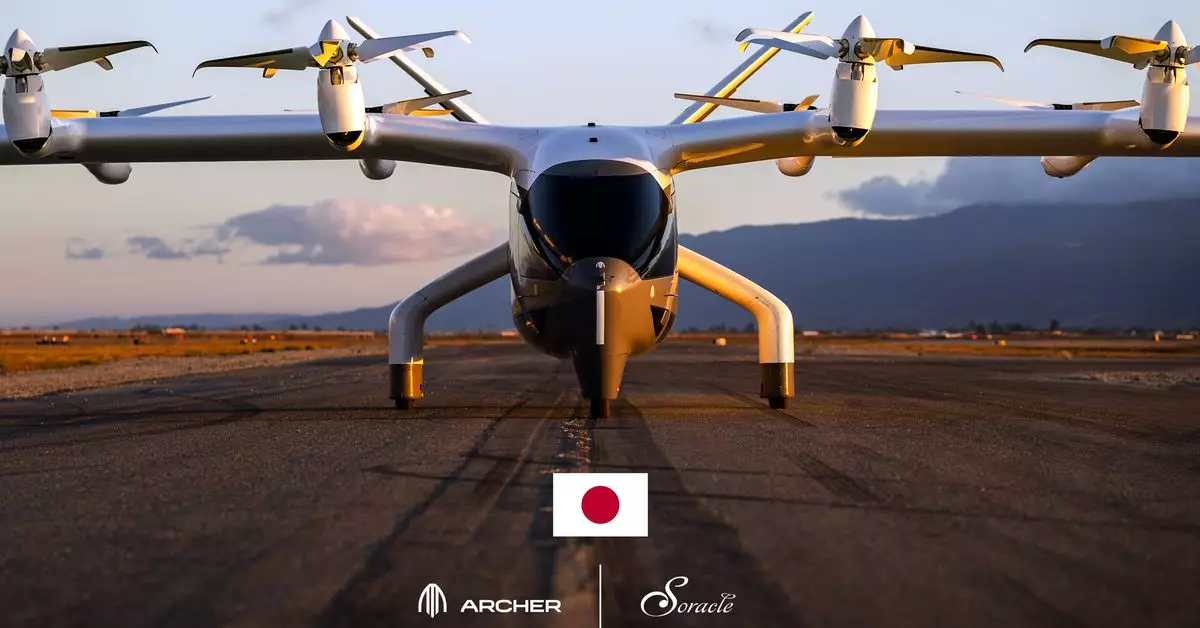In an era defined by rapid technological progress and environmental concerns, the aviation industry is undergoing a transformative shift towards electric flight. At the forefront of this movement is Archer Aviation, a company based in San Jose, California, known for its innovative approach to urban air mobility. By focusing on the development of electric vertical takeoff and landing (eVTOL) aircraft, Archer is not just riding the wave of the electric vehicle revolution; it is actively reshaping the future of transportation. With a recent deal to sell 100 of its Midnight aircraft to the Japanese joint venture Soracle, Archer is poised to make a significant impact in one of the world’s most technologically advanced nations.
The partnership with Soracle—a collaboration between Japan Airlines and Sumitomo Corporation—marks a significant milestone for Archer, with the deal valued at approximately $500 million. This large-scale aircraft deployment is designed to address the pressing challenges of urban transportation in densely populated areas. Archer’s Midnight aircraft, resembling a hybrid between a drone and a helicopter, promises to deliver an innovative solution to cities facing heavy traffic congestion and geographical barriers that hamper traditional transportation methods.
However, this ambitious endeavor is not without its challenges. Archer must first meet specific milestones related to aircraft delivery before receiving pre-delivery payments from Soracle. This requirement underscores the diligence and level of scrutiny involved in launching new aviation technologies, particularly in regions known for their regulatory standards and commitment to safety.
The Midnight aircraft is engineered to accommodate four passengers and a pilot, boasting a range of up to 100 miles (approximately 160 kilometers) and a top speed of 150 mph (241 km/h). Designed for efficiency, it is particularly suited for back-to-back flights covering shorter distances of 20 to 50 miles, allowing for quick recharging between flights. The aircraft utilizes tilt rotor technology, which enables it to take off and land vertically like a traditional helicopter, but transition into forward flight akin to an airplane. This versatile design not only enhances operational flexibility but also aligns with the increasing demand for sustainable air travel solutions.
Navigating the regulatory landscape is crucial for the successful deployment of eVTOL aircraft. Archer is actively pursuing compliance with the Japanese Civil Aviation Bureau (JCAB) and plans to apply for concurrent type certificate validation, which would allow it to operate within Japan. The company’s recent achievement of a Part 135 air carrier certification from the U.S. Federal Aviation Administration (FAA) signifies progress toward achieving the necessary certifications for on-demand air taxi services.
Importance is placed on safety and regulatory adherence, as these factors will ultimately determine the success of air taxi operations. With the FAA having released final regulations for eVTOL vehicles, the clear guidelines will facilitate a pathway to safe operations in the U.S. and potentially set a precedent for international standards.
The Emerging eVTOL Market: Opportunities and Challenges
While Archer is ambitious in its plans, it is not alone. Other eVTOL companies, including Joby Aviation, Volocopter, and Beta Technologies, share a vision for the future of air transportation that emphasizes sustainability and efficiency. However, the industry is not without its pitfalls; some contenders have struggled, as seen with German company Lilium, which recently declared insolvency for two of its subsidiaries. This volatility highlights the difficulties inherent in pioneering advanced transportation technologies, which often require substantial investment, time, and rigorous testing to achieve market readiness.
As cities grapple with the challenges of congestion and environmental impact, the potential for air taxis to serve as a complementary mode of transport is becoming increasingly evident. Archer’s foray into Japan epitomizes the potential of eVTOL technology to revolutionize urban mobility, but the broader industry will need to navigate not just technical and regulatory barriers but also public acceptance and operational viability.
The announcement of Archer Aviation’s air taxi plans in Japan represents a significant leap toward the realization of urban air mobility. While there are challenges ahead, the company’s commitment to innovation, safety, and partnership—coupled with the historic deal with Soracle—positions it as a key player in redefining how we approach transportation in urban landscapes. The success of this venture could very well set a new standard for air travel, inspiring the global transition toward sustainable and efficient mobility solutions. As we look ahead, it is clear that the skies may soon become bustling with urban air taxis, forever changing our relationship with transportation.


Leave a Reply
You must be logged in to post a comment.